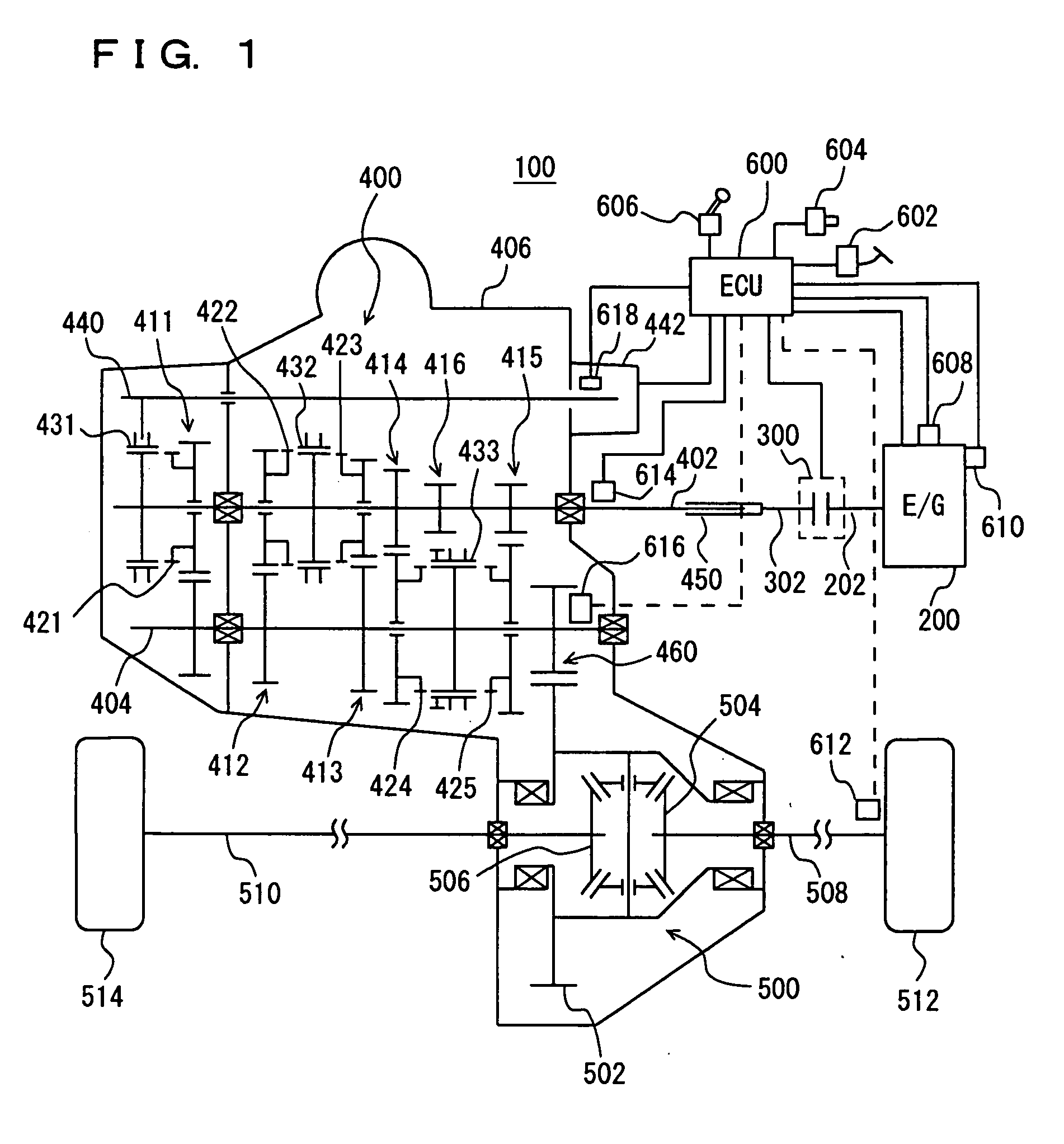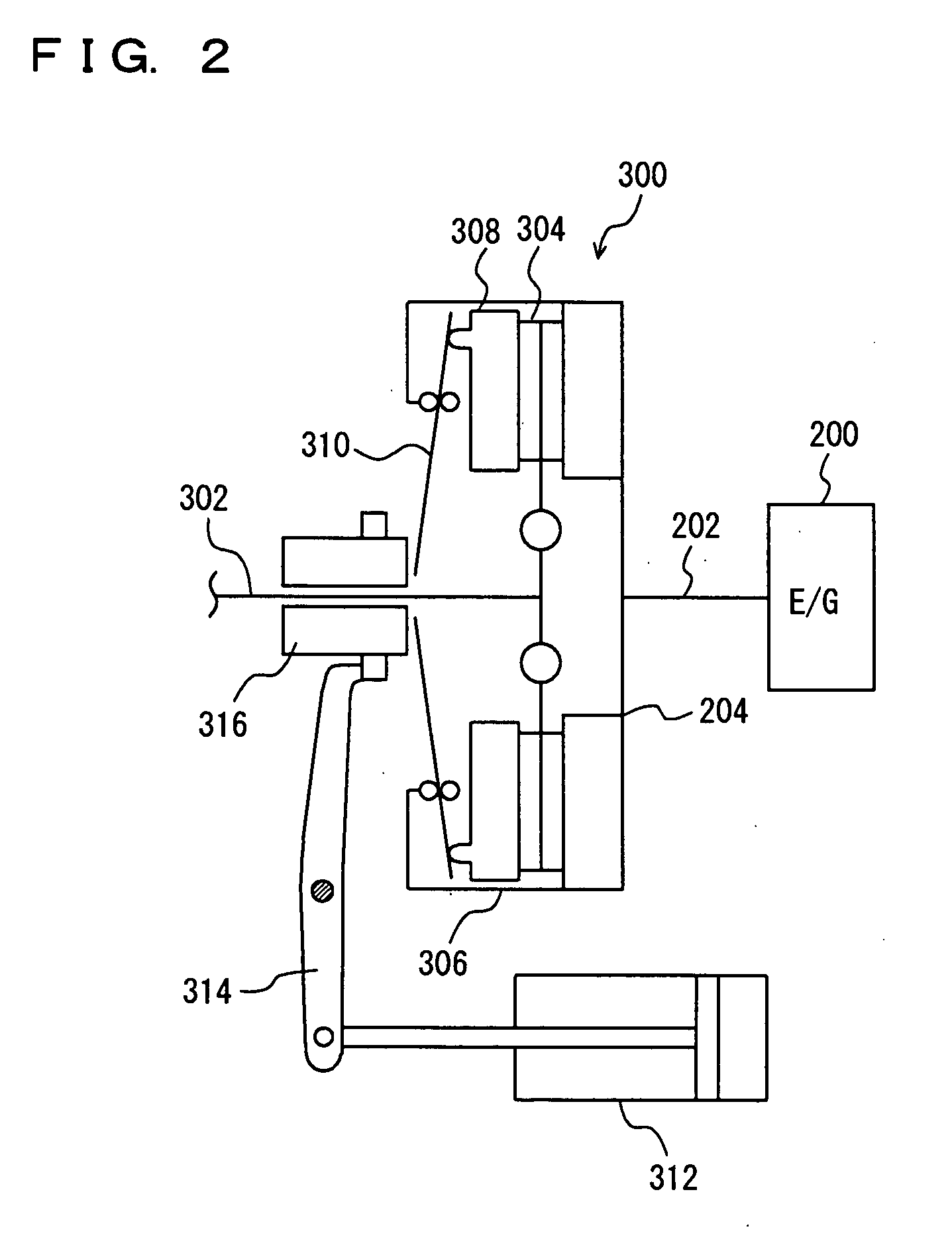[0009] An object of the present invention is to provide a gear shifting completion determining device and a gear shifting completion determining method that can appropriately determine completion of gear shifting.
[0011] According to this invention, when the
stroke amount of the actuator reaches the threshold
value set based on the operating state of the vehicle, it is determined that gear shifting of the transmission has completed. A sleeve and a gear would not readily mesh with each other when the vehicle is stopped, for example. In this case, the hardware such as the
gear train would likely suffer deflection due to the load applied to the transmission by the actuator. In contrast, the sleeve and the gear would readily mesh with each other while the vehicle is running, compared to the standstill state, so that the hardware such as the gear
train and the actuator would hardly suffer deflection. Accordingly, the threshold value is set to a value in the direction where the sleeve and the gear would mesh with each other more firmly when the vehicle speed is lower than when the vehicle speed is higher. In this manner, it is possible to set an appropriate threshold value taking account of deflection when the hardware such as the gear
train and the actuator would likely suffer deflection. This can suppress erroneous determination that the gear shifting has completed even if the gear shifting has not finished yet. On the other hand, in the case where deflection would hardly occur, it is possible to set an appropriate threshold value taking no account of deflection. This can suppress the undesired situation where it is determined that the gear shifting has completed at a timing later than the actual completion timing of the gear shifting. As a result, it is possible to provide a gear shifting completion determining device capable of appropriately determining completion of the gear shifting.
[0013] According to this invention, the threshold value is set to a value in the direction where the parts (for example, sleeve and gear) would mesh with each other more firmly when the vehicle speed is lower than when the vehicle speed is higher. As such, it is possible to set an appropriate threshold value taking account of deflection during the stopped state of the vehicle, for example, when the hardware such as the gear
train would likely suffer deflection. As such, it is possible to suppress erroneous determination that the gear shifting has completed even if the gear shifting has not finished yet. Further, an appropriate threshold value taking no account of deflection can be set while the vehicle is running or the like when the hardware such as the gear train would hardly suffer deflection. Thus, it is possible to suppress determination of completion of gear shifting at a timing later than the actual completion timing of the gear shifting. As a result, completion of the gear shifting can be determined appropriately.
[0017] According to this invention, when the stroke amount of the actuator has reached a threshold value that is set based on an operating state of the vehicle, it is determined that the gear shifting of the transmission has completed. A sleeve and a gear would not readily mesh with each other when the vehicle is stopped, for example. In this case, the hardware such as the gear train would likely suffer deflection due to the load applied to the transmission by the actuator. In contrast, the sleeve and the gear would readily mesh with each other while the vehicle is running, compared to the standstill state, so that the hardware such as the gear train and the actuator would hardly suffer deflection. Accordingly, the threshold value is set to a value in the direction where the sleeve and the gear would mesh with each other more firmly when the vehicle speed is lower than when the vehicle speed is higher. In this manner, it is possible to set an appropriate threshold value taking account of deflection when the hardware such as the gear train and the actuator would likely suffer deflection. This can suppress erroneous determination that the gear shifting has completed even if the gear shifting has not finished yet. On the other hand, in the case where deflection would hardly occur, it is possible to set an appropriate threshold value taking no account of deflection. This can suppress the undesired situation where it is determined that the gear shifting has completed at a timing later than the actual completion timing of the gear shifting. As a result, it is possible to provide a gear shifting completion determining method capable of appropriately determining completion of the gear shifting.
[0019] According to this invention, the threshold value is set to a value in the direction where the parts (for example, sleeve and gear) would mesh with each other more firmly when the vehicle speed is lower than when the vehicle speed is higher. As such, it is possible to set an appropriate threshold value taking account of deflection during the stopped state of the vehicle, for example, when the hardware such as the gear train would likely suffer deflection. As such, it is possible to suppress erroneous determination that the gear shifting has completed even if the gear shifting has not finished yet. Further, an appropriate threshold value taking no account of deflection can be set while the vehicle is running or the like when the hardware such as the gear train would hardly suffer deflection. Thus, it is possible to suppress determination of completion of gear shifting at a timing later than the actual completion timing of the gear shifting. As a result, completion of the gear shifting can be determined appropriately.
 Login to View More
Login to View More  Login to View More
Login to View More 


